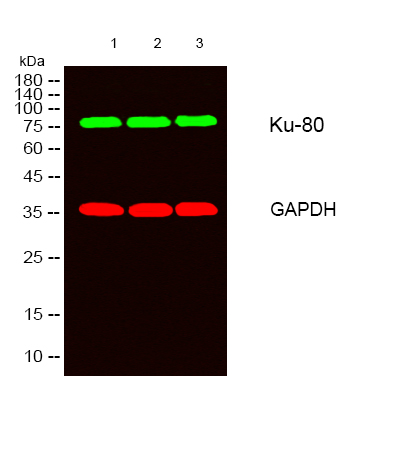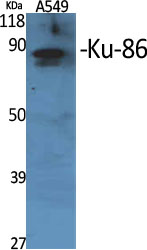ROR2 (Phospho Ser449) rabbit pAb
- Catalog No.:YP1734
- Applications:WB
- Reactivity:Human;Mouse;Rat
- Target:
- ROR2
- Fields:
- >>Wnt signaling pathway
- Gene Name:
- ROR2 NTRKR2
- Protein Name:
- ROR2 (Phospho-Ser449)
- Human Gene Id:
- 4920
- Human Swiss Prot No:
- Q01974
- Mouse Swiss Prot No:
- Q9Z138
- Immunogen:
- Synthesized peptide derived from human ROR2 (Phospho-Ser449)
- Specificity:
- This antibody detects endogenous levels of ROR2 (Phospho-Ser449) at Human, Mouse,Rat
- Formulation:
- Liquid in PBS containing 50% glycerol, 0.5% BSA and 0.02% sodium azide.
- Source:
- Polyclonal, Rabbit,IgG
- Dilution:
- WB 1:500-2000
- Purification:
- The antibody was affinity-purified from rabbit serum by affinity-chromatography using specific immunogen.
- Concentration:
- 1 mg/ml
- Storage Stability:
- -15°C to -25°C/1 year(Do not lower than -25°C)
- Other Name:
- Tyrosine-protein kinase transmembrane receptor ROR2 (EC 2.7.10.1) (Neurotrophic tyrosine kinase, receptor-related 2)
- Molecular Weight(Da):
- 104kD
- Background:
- The protein encoded by this gene is a receptor protein tyrosine kinase and type I transmembrane protein that belongs to the ROR subfamily of cell surface receptors. The protein may be involved in the early formation of the chondrocytes and may be required for cartilage and growth plate development. Mutations in this gene can cause brachydactyly type B, a skeletal disorder characterized by hypoplasia/aplasia of distal phalanges and nails. In addition, mutations in this gene can cause the autosomal recessive form of Robinow syndrome, which is characterized by skeletal dysplasia with generalized limb bone shortening, segmental defects of the spine, brachydactyly, and a dysmorphic facial appearance. [provided by RefSeq, Jul 2008],
- Function:
- catalytic activity:ATP + a [protein]-L-tyrosine = ADP + a [protein]-L-tyrosine phosphate.,developmental stage:Expressed at high levels during early embryonic development. The expression levels drop strongly around day 16 and there are only very low levels in adult tissues.,disease:Defects in ROR2 are a cause of brachydactyly type B1 (BDB1) [MIM:113000]. BDB1 is an autosomal dominant skeletal disorder characterized by hypoplasia/aplasia of distal phalanges and nails. In BDB1 the middle phalanges are short but in addition the terminal phalanges are rudimentary or absent. Both fingers and toes are affected. The thumbs and big toes are usually deformed.,disease:Defects in ROR2 are a cause of recessive Robinow syndrome (RRS) [MIM:268310]. RRS is an autosomal disorder characterized by skeletal dysplasia with generalized limb bone shortening, segmental defects of the spine, brachydactyly and a
- Subcellular Location:
- Cell membrane ; Single-pass type I membrane protein .
- Expression:
- Brain,
- June 19-2018
- WESTERN IMMUNOBLOTTING PROTOCOL
- June 19-2018
- IMMUNOHISTOCHEMISTRY-PARAFFIN PROTOCOL
- June 19-2018
- IMMUNOFLUORESCENCE PROTOCOL
- September 08-2020
- FLOW-CYTOMEYRT-PROTOCOL
- May 20-2022
- Cell-Based ELISA│解您多样本WB检测之困扰
- July 13-2018
- CELL-BASED-ELISA-PROTOCOL-FOR-ACETYL-PROTEIN
- July 13-2018
- CELL-BASED-ELISA-PROTOCOL-FOR-PHOSPHO-PROTEIN
- July 13-2018
- Antibody-FAQs
- Products Images

- Western Blot analysis of 1HeLa cell, 2 LPS 100ng/mL 30min treated ,using primary antibody at 1:1000 dilution. Secondary antibody(catalog#:RS23920) was diluted at 1:10000

